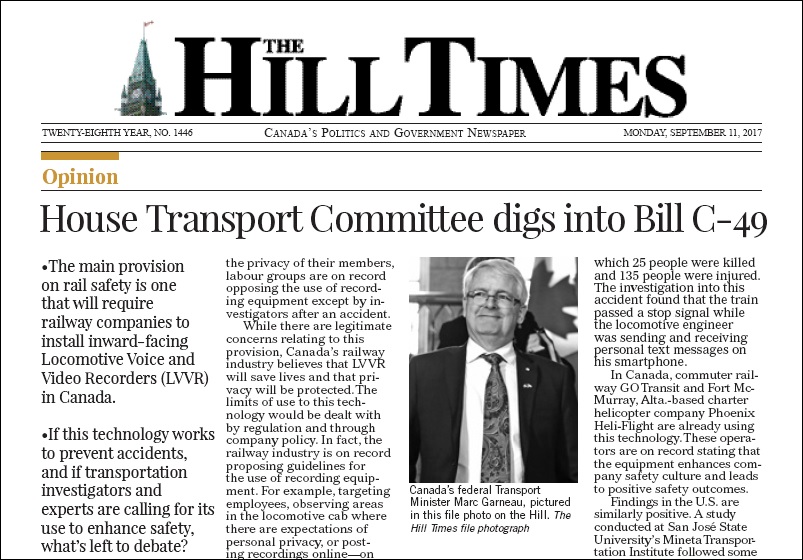House Transport Committee digs into Bill C-49
A letter by RAC President and CEO Michael Bourque concerning the use of Locomotive Voice and Video Recorders (LVVR) in Canada appeared in the Sept. 11, 2017 print edition of The Hill Times and online. Read the letter below or click the image to download a PDF version.

House Transport Committee digs into Bill C-49
Before Parliament resumes next week, the parliamentary standing committee on transport will return to Ottawa early to study Bill C-49, the Transportation Modernization Act, which includes provisions for rail service and safety.
The main provision on rail safety is one that will require railway companies to install inward-facing Locomotive Voice and Video Recorders (LVVR) in Canada.
This provision will no doubt result in debate. Citing the privacy of their members, labour groups are on record opposing the use of recording equipment except by investigators after an accident.
While there are legitimate concerns relating to this provision, Canada’s railway industry believes that LVVR will save lives and that privacy will be protected. The limits of use to this technology would be dealt with by regulation and through company policy. In fact, the railway industry is on record proposing guidelines for the use of recording equipment. For example, targeting employees, observing areas in the locomotive cab where there are expectations of personal privacy, or posting recordings online – on YouTube or other social media platforms – would be prohibited.
In addition, there are tests that the privacy commissioner has used in the past to guide us on how to use these technologies in the workplace. In a 2003 case involving recording at a railway workplace, the privacy commissioner determined that the rail company’s use of digital video cameras was reasonable and useful in answering four key questions: Is the measure demonstrably necessary to meet a specific need? Is it likely to be effective in meeting that need? Is the loss of privacy proportional to the benefit gained? Is there a less privacy-invasive way of achieving the same end?
In today’s railway operating environment, activities and communications are tracked by locomotive event recorders – devices that register data about train operations – and external, outward-facing cameras. In addition, railways use information from cameras in rail yards, radio communications with the rail traffic controllers and first-person observations of train operations as tools to enhance safety. These activities could not be undertaken without considering questions of privacy.
Most importantly, the Transportation Safety Board (TSB), the independent body that investigates transportation accidents and reports to Parliament, is calling for the use of LVVR for investigations and for proactive use by railway companies as part of their Safety Management System (SMS).
The National Transportation Safety Board, the TSB’s U.S. equivalent, has also called for the installation and proactive use of this technology. Their recommendation follows numerous accidents and fatalities, including a 2008 collision involving a commuter train in Chatsworth, Calif. in which 25 people were killed and 135 people were injured. The investigation into this accident found that the train passed a stop signal while the locomotive engineer was sending and receiving personal text messages on his smartphone.
In Canada, commuter railway GO Transit and Fort McMurray, Alta.-based charter helicopter company Phoenix Heli-Flight are already using this technology. These operators are on record stating that the equipment enhances company safety culture and leads to positive safety outcomes.
Findings in the U.S. are similarly positive. A study conducted at San José State University’s Mineta Transportation Institute followed some 20,000 transit buses equipped with audio-video equipment. They found that the technology resulted in a 40 per cent reduction in collisions per million miles travelled and a 30 per cent decline in passenger injuries. They also reported findings of up to a 50 per cent reduction in unsafe driving events.
If this technology works to prevent accidents, and if transportation investigators and experts are calling for its use to enhance safety, what’s left to debate? When the next preventable accident occurs, people opposed to the expanded use of LVVR must explain to the families and loved ones of those affected if privacy was worth the lives lost.
When the safety of many is in the hands of very few, Canada’s railways take the view that safety comes first.
-30-
Contact:
Communications
613-564-8101
communications@railcan.ca
About the Railway Association of Canada
The Railway Association of Canada (RAC) represents more than 50 freight and passenger railway companies that move close to 82 million passengers and more than $280 billion worth of goods in Canada each year. The RAC advocates on behalf of its members and associate members to ensure that the rail sector remains globally competitive, sustainable and, most importantly, safe. Learn more at railcandev.wpengine.com. Connect with us on Twitter, Facebook and LinkedIn.